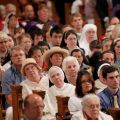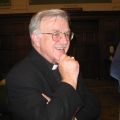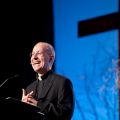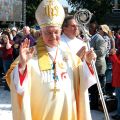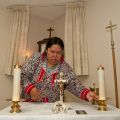Finish well what God has begun in you
The following is adapted from a homily preached by Fr. de Souza at a Mass for the 10th anniversary of his ordination, on July 20, 2012.
KRAKOW, POLAND - In this historic chapel of the residence of the archbishops of Krakow, Cardinal Stanislaus Dziwisz has now fashioned a fitting shrine to its most famous resident, Cardinal Karol Wojtyla.
The new reredos imaginatively includes the churches linked to the life of Blessed John Paul II — his baptismal church in Wadowice; the sanctuary of the Queen of Poland at Czestochowa; the Mariacki church of Krakow’s heart; Our Lady of Fatima, the protectress of the pope’s life; the Holy Sepulchre of Jerusalem, the destination of his epic Jubilee pilgrimage; Wawel, his seat as successor of St. Stanislaus; the Vatican basilica, his Roman home as the successor of St. Peter; and the shrine of Divine Mercy, the mystery of which, as Cardinal Ratzinger said in his funeral homily, was the key to John Paul’s entire teaching, and the shrine of which the late pope consecrated on his farewell visit to this, his beloved Krakow, in 2002.
That was 10 years ago next month. A few weeks before he returned to Krakow to consecrate the shrine of Divine Mercy, Blessed John Paul II was in Canada for Toronto’s World Youth Day. As part of those events, I was ordained a priest of Jesus Christ in Kingston, 10 years ago today. And a few weeks before that I came to Krakow to rejoin for a few days the seminar which first brought me to this city in 1994. During those days I came to pray in this chapel, the very chapel where Karol Wojtyla was ordained a priest on All Saints Day 1946.
I prayed then for the gift of the priesthood that awaited me; I return today to give thanks to the mercy of God for 10 years of priestly life. I return with my own parents, who made of our home a domestic church where the One greater than the temple found a place to dwell. After God Himself, to them belongs the gratitude of the Church for my priestly vocation and whatever fruit there has been from these 10 years of work in the Lord’s vineyard.
I come today also with George Weigel, and in him is represented the Krakow seminar that was for me a decisive step on the path to the priesthood. To him God gave the great mission of explaining to the world who John Paul II is, and George knew that this extraordinary Christian disciple had to be explained “from the inside” not from the “outside.” In this chapel one now sees, behind the altar, the churches of Karol Wojtyla’s life, but in the tabernacle one beholds the mystery that is the window to understanding him from the inside.
It was in this house that the young Karol Wojtyla would come to know Adam Sapieha, the prince archbishop, who, George Weigel tells us in Witness to Hope, “would be his model of Church leadership for more than half a century.” Archbishop Sapieha, made a cardinal after the war, was the great defender of the Church and the people during the long night of the occupation. He courageously opened a clandestine seminary in this residence, and the young men would often come to serve the archbishop’s Mass here.
Karol Wojtyla came, as did another young man, Jerzy Zachuta. In April 1944, Jerzy was killed by the Gestapo. Later that year, Wojtyla and the others would move into this house, it being too dangerous to live outside in their own city. For Jerzy Zachuta his vocation finished almost as soon as it started. The Lord had a different plan for Karol Wojtyla.
“For some time I thought about the possibility of becoming a Carmelite,” John Paul would write in 1996. “My uncertainties were resolved by Archbishop Cardinal Sapieha, who — in his usual manner — said briefly: ‘You should first of all finish what you started.’ And that is what I did.”
It was an unusual answer, because finishing what he started meant, among other things, not becoming a Carmelite. Yet the unbroken prince archbishop spoke more providently than he knew; Karol Wojtyla would not finish what he started until he had done what the other great Polish cardinal of the 20th century, Stefan Wyszynski, prophesied, namely to lead the Church across the threshold of hope into the third Christian millennium.
Finish what you have started. The Christian life might be summed up as just that — finish well what God has begun in you at baptism. It can summarize the great Christian pilgrimage through history. What my parents have done, what I and my brother and sisters must do, is to continue what has been lived by so many generations of faithful Catholics in our family. I carry in my heart today in particular the witness of my late grandmothers; I offered my first Mass for them 10 years ago, and I offer this Mass for them today.
We do not know the finish. We walk by faith and trust in God. Yet I do know this, that the past 10 years have been a blessing beyond measure, that I cannot imagine another life that would have brought me more joy — or allowed me to have more fun! — than the great adventure of being a Catholic priest in the third millennium.
I am a Catholic priest. That declaration is a sombre one to make in Krakow, as the image of St. Maximilian Kolbe in the church across the street reminds us. The Lord has not asked of me hardship, or even difficulty. He has granted me instead a full measure, pressed down and overflowing, the hundredfold return, and as yet without persecutions. Perhaps they will come; perhaps they will not. We do not know how we will finish.
On July 20, 2002, the Most Reverend Francis John Spence, archbishop of Kingston, took my hands in his and said to me: “May God who has begun this good work in you now bring it to fulfilment.”
We might translate that into the history of this chapel: You must finish what you have started. Amen.
These are a few of my favourite (P.E.I.) things
While on our annual family vacation to Prince Edward Island in July, a visiting friend from Ontario made an intriguing remark about her first impression of the island.
“I simply cannot get over how Catholic P.E.I. seems to be,” she said.
Such an impression never occurred to me. But her not being Catholic obviously gave her a different perspective.
“Don’t get me wrong, I am not being critical,” she said. “I just mean driving here from the (Confederation) Bridge we saw so many pretty little Catholic churches, we’ve heard about the lobster suppers in Catholic churches and there just seems to be a ‘Catholic feel’ to the place.”
We had a nice visit that afternoon with our friends and nothing more was said on the topic. But it got me thinking. She had a point. In fact, about half the population of 140,000 in P.E.I. is Catholic, according to Statistics Canada.
Then I started thinking about some of my favourite “Catholic” things on the island and I quickly came up with a tidy little list. (We’ve been visiting P.E.I. each summer for almost a decade after buying a cottage, which we rent when we’re not there.)
We’ve all heard the tourist spiel about Anne of Green Gables, white sandy beaches, the quaint red clay roads and the fabulous P.E.I. golf courses. And we might think potatoes or lobster when P.E.I. is mentioned, but Catholic is not a word that typically comes top of mind.
So, here are some tourist ideas for things to check out with Catholic flavour the next time you are, as the locals say, “on island.”
o The Confederation Trail is a walking and biking trail from one tip of the island to the other. The trail used to be the railway lands. I have not ridden the entire trail but I have found no prettier ride than the 12 kilometres from Morell to St. Peter’s. Most of the ride you’ll have a beautiful view of St. Peter’s Bay with the stately old St. Peter’s Church majestically standing on the hill across the bay. There are many places to stop along the trail for a picnic lunch and a clear vista of the big white church, which is generally open for a visit and with Sunday Mass at 11 a.m.
o St. Dunstan’s Basilica in Charlottetown is a century-old stone French Gothic church built from the remains of the cathedral that had been damaged by fire in 1913. It is the fourth church on the site and one of the most visible landmarks in Charlottetown with its three copper spires being some of the highest points on the city skyline. It is the only Roman Catholic cathedral in the province and one of the most elaborate churches in the Maritimes. The marble altar is 10 metres high and if you look closely at the ribs in the ceiling, you’ll see symbols of the Allied nations in the First World War, which was raging during St. Dunstan’s construction. Guided tours are available but you’re also welcome to quietly visit on your own or attend Mass.
o Ceilidhs (pronounced kaylees) are a fun part of the musical culture in P.E.I. Though not specifically Catholic, the Ceilidh tradition of singing, dancing, fiddling and strumming occurs in many churches and halls around the island. Ceilidhs began some years ago as weekend “kitchen parties” and now they are open to the general public and occur most nights of the week in summer. Each year, we attend a couple of Ceilidhs, especially the Crane Family Ceilidh at the refurbished St. Andrew’s Chapel in Mount Stewart, near our cottage.
o St. Andrew’s Chapel is significant on its own. It was the first church built in P.E.I. by Scottish settlers in 1772. In 1864 it was moved by horse and men on the ice down the river 28 kilometres to Charlottetown where it was converted into a school by the Sisters of Notre Dame. Later abandoned, it was restored and renovated and returned to Mount Stewart in 1998. Next to the chapel is the burial site of Fr. Angus MacEachern, the first bishop of P.E.I. His story is worth exploring and available at the site.
o St. Mary’s Church is the largest wood church in the province and is renowned for its acoustics. Located near Cavendish in Kensington, it hosts the Indian River Festival with world-class vocalists and musicians. It attracts tourists and singers the world over, as well as worshippers every Sunday morning at 9:30 a.m.
o The Chez Shea Inn and Spa is a former convent only minutes from the Confederation Bridge. We’ve never stayed overnight at the beautiful old three-storey building, but are told it is spiritually rejuvenating, although perhaps not as healing as the Sisters of St. Martha who used to reside there. Its grounds are peaceful amid a colourful and fragrant garden.
A quick word about the P.E.I. lobster suppers; they are no longer run by church councils or CWL members. They are run by for-profit businesses in a few churches and restaurant halls. If you love lobster, they are worth checking out but the ambiance is more like a restaurant than an old-fashioned church supper.
I am sure there are plenty more Catholic sites in P.E.I. and I expect to find more during our future visits.
- By Robert Brehl
America’s most cherished liberty under attack
On the Fourth of July, the Catholic Church in the United States turned toward Washington, not for the fireworks, nor for a windy speech from the president, but for the conclusion of what the American bishops declared to be a Fortnight for Freedom.
I followed it rather more closely than most, since I was appointed last year a consultant to the American bishops Ad Hoc Committee for Religious Liberty. Alarmed at encroachments on religious liberty at home, and escalating violence against Christians abroad, the ad hoc committee of senior bishops proposed a special fortnight of prayer, fasting, catechesis and public action in defense of religious liberty. Summoning forth “all the energies the Catholic community can muster,” the fortnight was a dramatic appeal to Americans — both Catholic and otherwise — to realize that their “first, most cherished liberty” is under sustained and serious attack.
Could it actually be that the media is on the side of life?
The parallels between abortion and euthanasia or assisted suicide are often cited during debates, especially by those who recall the role played by the media and the courts in first liberalizing Canada’s abortion laws and later eliminating them. But over the past few weeks we have seen a striking difference emerge.
Decades ago, almost all media outlets supported liberalization of abortion laws. In recent weeks, however, media reaction to a B.C. court decision striking down Canada’s assisted suicide laws has been anything but unanimous. Even editorials supportive of the decision have acknowledged the vulnerability of the elderly and disabled, and pointed out the potential for abuse through a more liberal law.
Opposing the court decision, the Vancouver Province said, “Allowing doctors to kill patients nearing the end of their lives, even with their consent, cheapens the sanctity of life, no matter how horrible the disease a patient is suffering from.”
Providing safeguards for medical killing is delusional
Tragedy at a Montreal psychiatric facility should stop proponents of medicalized killing dead in their tracks.
On June 16, one day after the B.C. Supreme Court struck down Canada’s laws against euthanasia and assisted suicide, someone in the high security psychiatric unit of the Centre Hospitalier Université de Montréal asphyxiated a patient. On June 21, a second patient was suffocated.
But here’s the thing: neither death was recognized as a homicide, let alone raised alarm bells, until the next day when an attempt to choke a third patient to death was foiled. A former slaughterhouse worker with a lengthy history of violent crime, who checked himself into the ward the very day the first patient was killed, was charged June 27.
In Calgary, eternal fatherhood is made manifest once more
CALGARY - Four new priests were ordained here on the Feast of Sts. John Fisher and Thomas More, a most grace-filled day for the diocese of Calgary in its centenary year. It was a blessing for me to be on hand to witness some family friends ordained, and then later to join in the joy of a First Mass at my home parish of St. Bonaventure.
Priestly ordinations are rather fewer than we need these days, so to have four young men is remarkable, all the more so as they all came from local parishes. Their vocation stories are a combination of old patterns and new ones. Two went almost straight from high school, the others after some time working. Their vocations were nourished in Catholic families and inspired by good priests. As is common today, World Youth Day had a significant impact too.
American Jesuit James Martin can find the humour in the Church
Jesuit Father James (Jim) Martin is quickly becoming one of my favourite religious writers and orators. And the more I read of his works or watch his talks on TV and the Internet, the more impressed I become.
This American Jesuit thinks clearly, speaks and writes directly, and best of all, he is funny, although he has serious messages. (He is the official chaplain of Comedy Network’s The Colbert Report where he sometimes appears.) He is a populist who endeavours to make Catholicism ever more popular.
If you’re looking for summer reading, Fr. Martin has several best-selling books, including My Life With the Saints, A Jesuit Off-Broadway: Centre Stage with Jesus, Judas and Life’s Big Questions, and the Jesuit Guide to Almost Everything.
- By Robert Brehl
My misgivings about Dublin congress leave me just a little embarrassed
I was a little embarrassed watching the coverage of the International Eucharistic Congress (IEC) in Dublin. Not because of anything that went on in Ireland, but rather because of my original attitude toward the congress being held there at all. Yet watching the pilgrims from around the world gathering in Dublin, I saw that their gestures of sympathy and solidarity were better than an attitude of ostracism and punishment.
When it was announced in 2008 at Quebec City that the 2012 IEC would be in Dublin, I was rather dismayed. I understood that sometimes a local Church in distress can be buoyed by such an international event — after all, that was the logic of having the IEC in Quebec City to begin with, to administer an emergency transfusion to the anemic local Church. Yet Dublin struck me as a step too far. After all, it would be hard to find any place where spectacular incompetence had brought the Church into greater crisis than in Ireland. And Irish society as a whole, led by its government, was hardly better.
Laity must join bishops in answering affronts to the Church
I cannot abide bishop bashing.
The habit in some Catholic circles of remorselessly denouncing and denigrating our prelates for perceived failures to lead, to act, to show courage, to boss the world about, sets my teeth on edge.
It is difficult to imagine a role outside the world of electoral politics that requires a broader back, a thicker skin and a finer ability to manage expectations than that of a North American Catholic bishop in 2012.
Are northern efforts coming at the expense of the new evangelization?
WHITEHORSE, YT - Last week I wrote about my impressions of the Yukon on my first trip to Canada’s north. In many ways it is altogether different from anything I have previously encountered in Canada’s cities, or even in my parish on Wolfe Island. At the same time the Yukon raises questions that the Church in all of Canada must face.
It is frankly astonishing that anyone lives in some of these remote communities, where a summer visitor is impressed by the natural beauty but year-round residents have to cope with isolation and lack of services, to say nothing of the severe cold and oppressive darkness of the punishing winter. To imagine living up here in the early 20th century, before roads and four-wheel drive trucks and propane gas heating and food preservatives is mindboggling, especially given that an overland trek of several weeks would deliver one into the Okanagan, one of the loveliest climates anywhere in the world.
Doggone it if I’m going to play God
They say you can’t teach old dogs new tricks, and that may be so.
But there is something special about an old dog, and he (or she) can often teach an owner a thing or two. Puppies are adorable, but old dogs are like comfortable shoes that when slipped on can sometimes walk us to unexpected places.
(If you’re not a pet lover, I implore you to stop reading immediately and move onto something else in The Register. These meanderings from a sappy dog lover will only frustrate you.)
- By Robert Brehl

